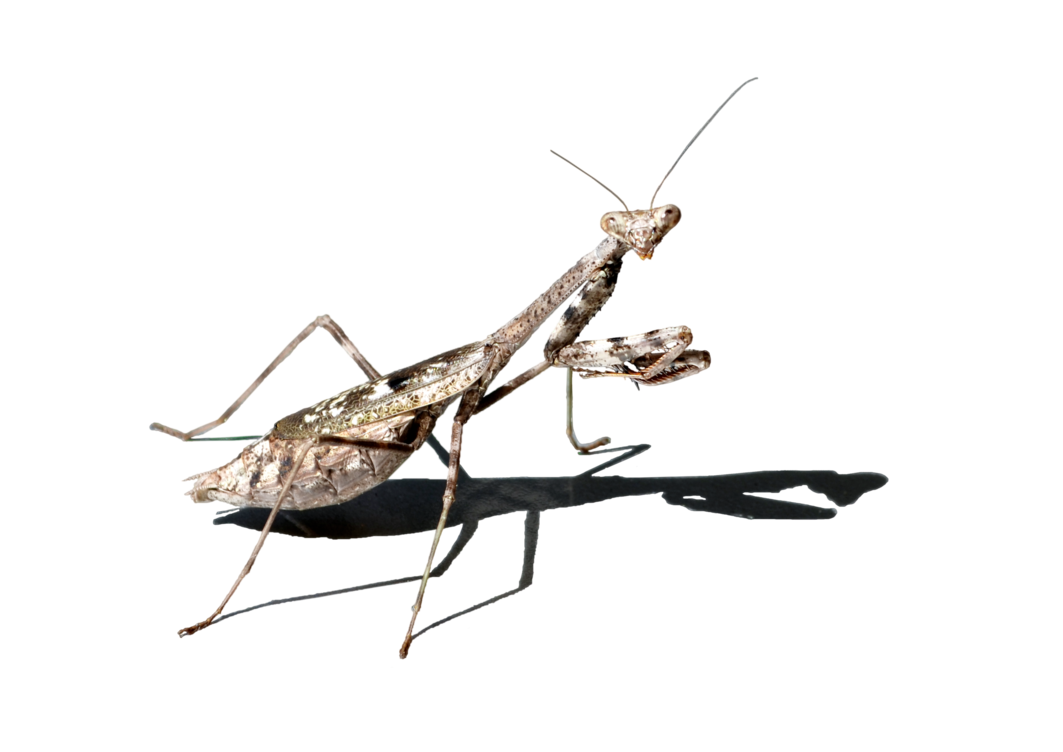
This image has format transparent PNG with resolution 1063x752.
You can download this image in best resolution from this page and use it for design and web design.
Mantis PNG with transparent background you can download for free, just click on download button.
Mantises are an order (Mantodea) of insects that contains over 2,400 species in about 430 genera in 15 families. The largest family is the Mantidae ("mantids"). Mantises are distributed worldwide in temperate and tropical habitats. They have triangular heads with bulging eyes supported on flexible necks. Their elongated bodies may or may not have wings, but all Mantodea have forelegs that are greatly enlarged and adapted for catching and gripping prey; their upright posture, while remaining stationary with forearms folded, has led to the common name praying mantis.
The closest relatives of mantises are the termites and cockroaches (Blattodea), which are all within the superorder Dictyoptera. Mantises are sometimes confused with stick insects (Phasmatodea), other elongated insects such as grasshoppers (Orthoptera), or other unrelated insects with raptorial forelegs such as mantisflies (Mantispidae). Mantises are mostly ambush predators, but a few ground-dwelling species are found actively pursuing their prey. They normally live for about a year. In cooler climates, the adults lay eggs in autumn, then die. The eggs are protected by their hard capsules and hatch in the spring. Females sometimes practice sexual cannibalism, eating their mates after copulation.
Mantises were considered to have supernatural powers by early civilizations, including Ancient Greece, Ancient Egypt, and Assyria. A cultural trope popular in cartoons imagines the female mantis as a femme fatale. Mantises are among the insects most commonly kept as pets.
Mantises have large, triangular heads with a beak-like snout and mandibles. They have two bulbous compound eyes, three small simple eyes, and a pair of antennae. The articulation of the neck is also remarkably flexible; some species of mantis can rotate their heads nearly 180°. The mantis thorax consists of a prothorax, a mesothorax, and a metathorax. In all species apart from the genus Mantoida, the prothorax, which bears the head and forelegs, is much longer than the other two thoracic segments. The prothorax is also flexibly articulated, allowing for a wide range of movements of the head and fore limbs while the remainder of the body remains more or less immobile.
Raptorial foreleg of a mantis, armed with long spines
Mantises have two spiked, grasping forelegs ("raptorial legs") in which prey items are caught and held securely. In most insect legs, including the posterior four legs of a mantis, the coxa and trochanter combine as an inconspicuous base of the leg; in the raptorial legs, however, the coxa and trochanter combine to form a segment about as long as the femur, which is a spiky part of the grasping apparatus (see illustration). Located at the base of the femur is a set of discoidal spines, usually four in number, but ranging from none to as many as five depending on the species. These spines are preceded by a number of tooth-like tubercles, which, along with a similar series of tubercles along the tibia and the apical claw near its tip, give the foreleg of the mantis its grasp on its prey. The foreleg ends in a delicate tarsus used as a walking appendage, made of four or five segments and ending in a two-toed claw with no arolium.
Mantises can be loosely categorized as being macropterous (long-winged), brachypterous (short-winged), micropterous (vestigial-winged), or apterous (wingless). If not wingless, a mantis has two sets of wings: the outer wings, or tegmina, are usually narrow and leathery. They function as camouflage and as a shield for the hind wings, which are clearer and more delicate. The abdomen of all mantises consists of 10 tergites, with a corresponding set of nine sternites visible in males and seven visible in females. The abdomen tends to be slimmer in males than females, but ends in a pair of cerci in both sexes.
In this page you can download free PNG images: Mantis PNG images free download